miR-221 promotes tumorigenesis in human triple negative breast cancer cells
- PMID: 23637992
- PMCID: PMC3634767
- DOI: 10.1371/journal.pone.0062170
miR-221 promotes tumorigenesis in human triple negative breast cancer cells
Retraction in
-
Retraction: miR-221 Promotes Tumorigenesis in Human Triple Negative Breast Cancer Cells.PLoS One. 2017 Apr 10;12(4):e0175869. doi: 10.1371/journal.pone.0175869. eCollection 2017. PLoS One. 2017. PMID: 28394920 Free PMC article. No abstract available.
Abstract
Patients with triple-negative breast cancers (TNBCs) typically have a poor prognosis. TNBCs are characterized by their resistance to apoptosis, aggressive cellular proliferation, migration and invasion, and currently lack molecular markers and effective targeted therapy. Recently, miR-221/miR-222 have been shown to regulate ERα expression and ERα-mediated signaling in luminal breast cancer cells, and also to promote EMT in TNBCs. In this study, we characterized the role of miR-221 in a panel of TNBCs as compared to other breast cancer types. miR-221 knockdown not only blocked cell cycle progression, induced cell apoptosis, and inhibited cell proliferation in-vitro but it also inhibited in-vivo tumor growth by targeting p27(kip1). Furthermore, miR-221 knockdown inhibited cell migration and invasion by altering E-cadherin expression, and its regulatory transcription factors Snail and Slug in human TNBC cell lines. Therefore, miR-221 functions as an oncogene and is essential in regulating tumorigenesis in TNBCs both in vitro as well as in vivo.
Conflict of interest statement
Figures
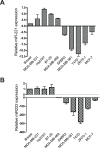
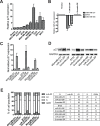
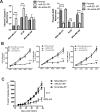
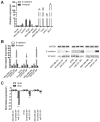
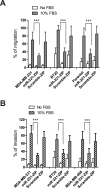
Similar articles
-
Triple-negative breast cancer-derived microvesicles transfer microRNA221 to the recipient cells and thereby promote epithelial-to-mesenchymal transition.J Biol Chem. 2019 Sep 13;294(37):13681-13696. doi: 10.1074/jbc.RA119.008619. Epub 2019 Jul 24. J Biol Chem. 2019. PMID: 31341019 Free PMC article.
-
MiR-92b inhibited cells EMT by targeting Gabra3 and predicted prognosis of triple negative breast cancer patients.Eur Rev Med Pharmacol Sci. 2019 Dec;23(23):10433-10442. doi: 10.26355/eurrev_201912_19682. Eur Rev Med Pharmacol Sci. 2019. PMID: 31841197
-
miR-3178 inhibits cell proliferation and metastasis by targeting Notch1 in triple-negative breast cancer.Cell Death Dis. 2018 Oct 17;9(11):1059. doi: 10.1038/s41419-018-1091-y. Cell Death Dis. 2018. PMID: 30333478 Free PMC article.
-
Wnt signaling in triple-negative breast cancers: Its roles in molecular subtyping and cancer cell stemness and its crosstalk with non-coding RNAs.Life Sci. 2022 Jul 1;300:120565. doi: 10.1016/j.lfs.2022.120565. Epub 2022 Apr 21. Life Sci. 2022. PMID: 35461838 Review.
-
Analysis of the function, mechanism and clinical application prospect of TRPS1, a new marker for breast cancer.Gene. 2025 Jan 10;932:148880. doi: 10.1016/j.gene.2024.148880. Epub 2024 Aug 23. Gene. 2025. PMID: 39181273 Review.
Cited by
-
MicroRNAs: novel players in cancer diagnosis and therapies.Biomed Res Int. 2014;2014:959461. doi: 10.1155/2014/959461. Epub 2014 Jul 2. Biomed Res Int. 2014. PMID: 25101302 Free PMC article. Review.
-
Changes in miR-221/222 Levels in Invasive and In Situ Carcinomas of the Breast: Differences in Association with Estrogen Receptor and TIMP3 Expression Levels.Mol Diagn Ther. 2016 Dec;20(6):603-615. doi: 10.1007/s40291-016-0230-3. Mol Diagn Ther. 2016. PMID: 27488105
-
Emerging ways to treat breast cancer: will promises be met?Cell Oncol (Dordr). 2018 Dec;41(6):605-621. doi: 10.1007/s13402-018-0409-1. Epub 2018 Sep 27. Cell Oncol (Dordr). 2018. PMID: 30259416 Review.
-
Deregulation of microRNA expression in thyroid neoplasias.Nat Rev Endocrinol. 2014 Feb;10(2):88-101. doi: 10.1038/nrendo.2013.223. Epub 2013 Nov 19. Nat Rev Endocrinol. 2014. PMID: 24247220 Review.
-
Specific micro-RNA expression patterns distinguish the basal and luminal subtypes of muscle-invasive bladder cancer.Oncotarget. 2016 Dec 6;7(49):80164-80174. doi: 10.18632/oncotarget.13284. Oncotarget. 2016. PMID: 27845906 Free PMC article.
References
-
- Bartel DP (2004) MicroRNAs: genomics, biogenesis, mechanism, and function. Cell 116: 281–297. - PubMed
-
- Lim LP, Lau NC, Garrett-Engele P, Grimson A, Schelter JM, et al. (2005) Microarray analysis shows that some microRNAs downregulate large numbers of target mRNAs. Nature 433: 769–773. - PubMed
-
- Lewis BP, Shih IH, Jones-Rhoades MW, Bartel DP, Burge CB (2003) Prediction of mammalian microRNA targets. Cell 115: 787–798. - PubMed
-
- Esquela-Kerscher A, Slack FJ (2006) Oncomirs - microRNAs with a role in cancer. Nat Rev Cancer 6: 259–269. - PubMed
-
- Ambros V (2004) The functions of animal microRNAs. Nature 431: 350–355. - PubMed
Publication types
MeSH terms
Substances
LinkOut - more resources
Full Text Sources
Other Literature Sources
Research Materials
Miscellaneous

